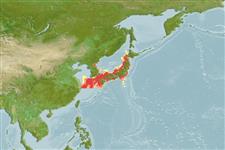Environment: milieu / climate zone / depth range / distribution range
Ecologia
marinhas demersal; oceanódromo (Ref. 51243). Subtropical; 45°N - 30°N
Northwest Pacific: southern Hokkaido to Kyushu and the southern Korean Peninsula (Ref. 559). Three morphotypes observed (reddish type; blackish type; brownish type), and may be reproductively isolated from each other (Ref. 44259).
Length at first maturity / Tamanho / Peso / Idade
Maturity: Lm ?, range 16 - ? cm
Max length : 35.9 cm TL macho/indeterminado; (Ref. 96735); peso máx. Publicado: 800.00 g (Ref. 40637)
Juveniles associate with drifting seaweed. Plankton feeder (Ref. 12114, 12115). Viviparous (Ref. 34817).
Males established territories ranging from 12 to 70 sq. m; initiated courtship when females approached the territories; lateral display, rushing and turning movements were frequently observed during courtship. Mating pair formed about 30 min before copulation; the pair ascended to 1.5-2.0 m above bottom then males suddenly coiled around the body of females to copulate.
Masuda, H., K. Amaoka, C. Araga, T. Uyeno and T. Yoshino, 1984. The fishes of the Japanese Archipelago. Vol. 1. Tokai University Press, Tokyo, Japan. 437 p. (text). (Ref. 559)
Categoria na Lista Vermelha da IUCN (Ref. 130435: Version 2024-1)
Ameaça para o homem
Harmless
Utilização humana
Pescarias: espécies comerciais; Aquacultura: espécies comerciais; peixe desportivo: sim
Ferramentas
Relatórios especiais
Descarregue XML
Fontes da internet
Estimates based on models
Preferred temperature (Ref.
123201): 9.3 - 22.1, mean 17.3 °C (based on 52 cells).
Phylogenetic diversity index (Ref.
82804): PD
50 = 0.5000 [Uniqueness, from 0.5 = low to 2.0 = high].
Bayesian length-weight: a=0.01288 (0.00989 - 0.01677), b=3.02 (2.96 - 3.08), in cm total length, based on LWR estimates for this species (Ref.
93245).
Nível Trófico (Ref.
69278): 4.0 ±0.67 se; based on food items.
Generation time: 4.4 ( na - na) years. Estimated as median ln(3)/K based on 1
growth studies.
Resiliência (Ref.
120179): Médio, tempo mínimo de duplicação da população 1,4 - 4,4 anos (K=0.25).
Fishing Vulnerability (Ref.
59153): Moderate vulnerability (38 of 100).
Nutrients (Ref.
124155): Calcium = 53.1 [20.6, 174.2] mg/100g; Iron = 0.62 [0.26, 1.68] mg/100g; Protein = 18.3 [17.0, 19.7] %; Omega3 = 0.645 [0.255, 1.731] g/100g; Selenium = 82.5 [29.3, 254.6] μg/100g; VitaminA = 10.6 [2.9, 40.2] μg/100g; Zinc = 0.447 [0.234, 0.827] mg/100g (wet weight);
